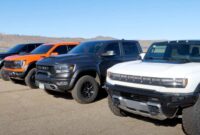The GMC Sierra EV has finally been revealed, giving buyers an additional option if they are in the market for an electric truck. However, it seems that current Ford Experience Design Director Ryan McManus isn’t completely entertained by the new GMC EV truck, especially with how its infotainment system is designed.
In a social media post via Twitter, McManus posted a photo of the Sierra EV’s vertically oriented infotainment system, along with a caption that said:
Hi @GM, we just sent you a CAD file for the Sync Knob, it might have saved you a few hours of work.
McManus is referring to the GMC Sierra EV’s infotainment button, which is located in the bottom center of the portrait screen. For reference, it certainly looks similar to how Ford designed the Sync infotainment system on the Ford Mustang Mach-E and F-150 Lightning, which you can see side by side above.
The similarities between the Ford and GMC systems don’t stop there. Just like Ford, the Sierra EV infotainment has climate control located at the bottom of the screen.
GMC has the edge on its screens. It features Google integration, bespoke customization, and split-screen capabilities. The knobs on the Sierra EV also have thick metal bezels.
That’s not the only advantage the Sierra EV has over the F-150 Lightning. Ford’s electric truck’s maximum EPA range is 320 miles (515 kilometers), which is slightly shorter than the estimated 400 mi (644 km) Sierra EV Denali Edition 1. The GMC is also much more powerful, with the announced dual-motor all-wheel drive system delivering up to 754 horsepower (562 kilowatts) and 785 pound-feet (1,063 Newton-meters) of torque in Max Power mode.
Do you think GMC is copying Ford’s Sync system button design as McManus implies? Let us know what you think in the comments section below.



